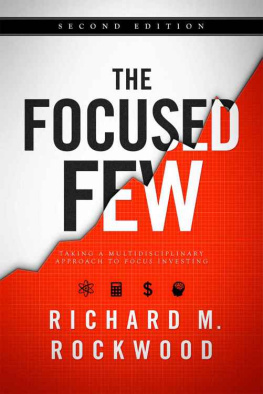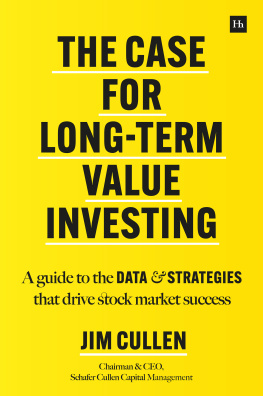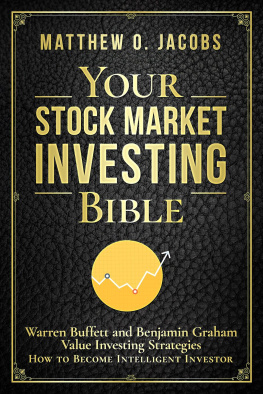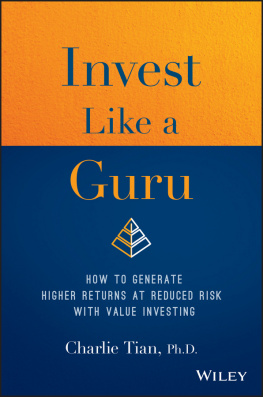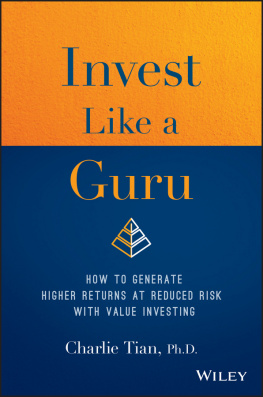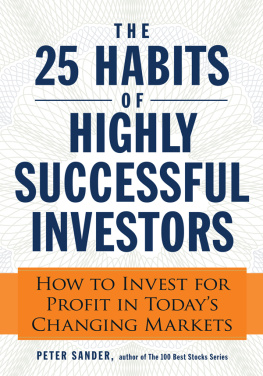Foreword
I FIRST BECAME ACQUAINTED WITH R ICH R OCKWOOD in cyberspace. Already in the late 1990s, in the nascent days of the Internet, Rich was running an excellent website (out of his Indiana University dorm room!) dedicated largely to providing information about Warren Buffett and Berkshire Hathaway. Buffetts status as an investment icon had yet to be fully recognized by the financial media. Investors who were avid followers of the Oracle of Omaha craved any new tidbits of wisdom, and Richs website helped fill that void. By January 2000, just 2 months before the tech crash of March 2000, Rich upgraded his website and called it FocusInvestor.com. And now comes his book The Focused Few.
The late 1990s were a testing time for value investors. As some will recall, the stock market was gripped in a mania for early-stage technology stocks. Massive valuations were being accorded to concept companies that were barely recording revenues, let alone profits. Wall Street investment banks fanned the flames as they pumped out overpriced IPOs, reaping massive underwriting profits. Many research analysts acted as accomplices to the charade by publishing glowing reports and assigning scandalous price targets to ethereal businesses. Unfortunately, countless Main Street investors drank the Kool-Aid.
Yet a cadre of investors (a focused few) who read Benjamin Graham and David Dodd were unpersuaded, preferring instead to watch the spectacle from the sidelines while occasionally picking up shares in ignored and undervalued businesses. They were frequently viewed as naysayers, supposedly out of touch with the New Era that promised a seemingly quick and easy path to riches.
When the bubble burst, those disciples of Graham and Doddsville who stuck to their principles were spared much of the 200003 market carnage. In fact, as the market indices sank, value stocks (yes, a focused few stocks) purchased at discounts to intrinsic value significantly outperformed most others during that stretch.
Certainly Rich Rockwoods experiences, early in his career as a young value investor beset by a classic market bubble, served to shape the first edition of The Focus Investor in 2004. That year Rich also would join our firm, Aldebaran Capital.
Like others in the rarefied club of value investors, Rich soon read and digested Graham and Dodd and got it. Many describe their initial experience studying a value-oriented philosophy as akin to the cartoonish caricature of a light bulb suddenly brightening over ones head. Something clicks. In the flash of that aha moment, investing makes sense. The newly minted value investor now has a framework for navigating the cross-currents of information and emotions that can be overwhelming.
This book appears in the aftermath of the 200809 financial crisis and the Great Recession. It is timely for readers who, after experiencing two major market upheavals in less than a decade, are naturally gun-shy about their investing future. By outlining seven creative and clear-cut investing principles, Rich Rockwood provides the wary investor with a reasoned road map.
Many investment books launch right into their methods of security selection. Instead, The Focused Few sets the table with how to think about investing. Warren Buffett has famously described this as the proper temperament needed to succeed as an investor.
Knowing Rich as I do, he clearly has developed an enthusiastic devotion to the culture that Warren Buffett and sidekick Charlie Munger have created over the past five decades at Berkshire Hathaway. Yet shining throughout The Focused Few is Richs imprimatur, his own unique approach to value investing.
A word about Charles T. Munger. In his gruff, direct and humorous style, Munger has contributed a significant body of work to the investment process. He also has been an outspoken commentator on some of societys thorniest problems. Munger is like a human think tank, with a propensity to challenge conventional norms from different angles.
The Focused Few advocates a Munger-like multidisciplinary approach that derives insight from a variety of life experiences, including scientific and psychological observations, to broaden ones mind to potential investment opportunities. The process examines human behavior and biases, which at first glance wouldnt necessarily be associated with investing.
In this book Rich Rockwood, like Munger, challenges conventional rules of investing. As the title of the book implies, one should focus his or her portfolio on a handful of well-chosen businesses. Rich provides the tools for analyzing the competitive marketplace and how companies, managers and investors must navigate carefully in order to be successful.
Perhaps more importantly, examples of what can trip up investors are discussed, along with methods of how to be prepared for the next market curve ball. The ability to recognize these distinctions in a volatile marketplace is the hallmark of a good investor. A focus investor.
I trust youll enjoy getting to know Rich Rockwood as much as I haveand also benefit from his wisdom and insights.
Ken Skarbeck
President/Managing Director
Aldebaran Capital, LLC
Indianapolis, Indiana
Acknowledgments
W RITING A BOOK INVOLVES MORE THAN JUST the author writing down his thoughts and trying to find a publisher. It takes a community to complete! I want to pause and thank those who made this book possible.
First, I want to thank my wife and daughter for graciously blessing my use of precious family time to write this bookthe first edition in 2004 and now the second edition a decade later. My father and grandfather also were incredibly supportive, even after listening to me talk for years about writing this book.
Dan Shenk of CopyProof and his assistant, Mark Garratt, are two especially important people involved in this book project. I gave them the manuscript to edit in in the spring of 2014, and their efforts made The Focused Few: Taking a Multidisciplinary Approach to Focus Investing much clearer and certainly more readable! Then Alison Sties worked her magic on the interior layout. Im also indebted to James T. Egan at Bookfly Design for his creative design of the cover.
Further, Im fortunate that several friends and associates took the time to help me develop this book. I would like to thank the following individuals for reviewing early drafts and providing comments and suggestions that greatly improved the overall quality: Rick Ebbinghouse, Ed Goodwin, Ankit Gupta, Jan-Hendrik Mohr, Matt Nellans, Larry Oberman, Sam Park and Timothy Vick.
I also wish to thank all of my teachers and mentorsnamely and chiefly Benjamin Graham, Warren Buffett, Charlie Munger and Philip Fisher who, in their writings and in person, explained their investing viewpoints. Without their unselfish guidance, my journey toward investment knowledge would have taken a much longer and less fruitful path.

